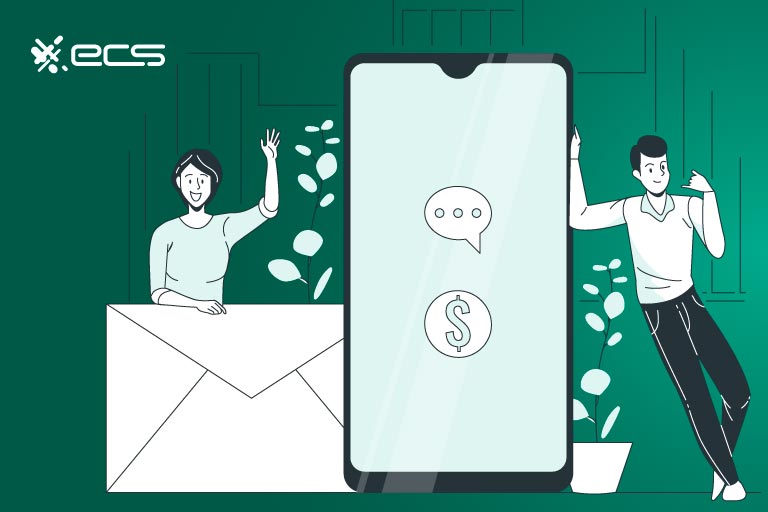Text to pay is an innovative new way of payment processing, especially for B2C sales. In a nutshell, it works by sending customers a payment link in a text message to their phone number. The customer can click over to a payment gateway and use a debit card, credit card, or other payment methods to complete their payment.
American Consumers Love Their Phones
The average American consumer spends a whopping 5.5 hours per day on their smartphone. Interestingly, the average person spends less than 7 hours a day sleeping, which means they’re spending almost as much time scrolling through Facebook as they are catching up on sleep.
The average American phone user touches their phone more than 2,600 times per day, checking their phone once at least every 10 minutes. Around 75% of phone users have anxiety about leaving their phones at home, and 60% of them sleep with their phones.
With stats like this, one might ask: are American consumers addicted to their phones? Maybe, maybe not…although 57% of them think they are. In any case, you can use this inseparable bond of man and pocket-sized screen to your advantage with text messaging payment.

How Does Mobile Payment SMS Fit Into the Payment Landscape?
Let’s now take a look at the broader payment landscape and see how pay by text fits in. Once upon a time, people paid for everything with gold, silver, seashells, and sometimes even salt. But most of these things are pretty easily found today. So you’re best off accepting money for payment.
By money, we mean digital payment instead of paper currency. Paper currency can provide hours of amusement hunting for Masonic imagery, but it’s rather inconvenient for most business owners. It’s easy to lose. It has to be deposited. And most importantly, the vast majority of consumers do not want to use it.
Consumers Do Not Like Using Cash
In fact, Pew Research has found that 41% of consumers don’t use cash for any of their everyday purchases, preferring card payments instead. Only 14% use cash frequently, and the remainder use cash some of the time.
Cash usage is also nuanced in terms of demographic breakdown. Around 54% of younger consumers (under 50) don’t care about having cash on hand. Consumers with higher incomes care less about using cash: only 6% of households making over $50,000 used cash for everyday purchases.
Cash doesn’t really talk much, either—despite social media posts of people holding stacks of Benjamin up to their ears like a telephone. The average cash transaction is just $22, compared to the average plastic transaction of $112. All in all, cash is no longer king.
Plastic Payment Solutions
Now on to card payments. The credit card was introduced in the 1950s, along with other cultural institutions like Mcdonald’s and Elvis Presley. Since then, card payments have become the preferred way for consumers to pay. According to the Federal Reserve, in 2021, a surprising 29% of consumers prefer debit cards, while 28% prefer credit cards. A combined cash, ACH, mobile wallet, and other make up the other 43%.
The first credit cards in America used magnetic strips to send information through card networks via the point-of-sale terminal. European cards relied on EMV chips, which have since become standard features of American cards. Although contactless payment technology was invented before the Covid Pandemic, its usage exploded in 2020-2022.
One type of contactless payment is mobile payment. These payments do not use the cellular network but rather activate an NFC chip inside the phone for sending and receiving radio waves from the POS terminal. No physical plastic credit or debit card is needed for the transaction—just the card information the consumer has saved in their mobile wallet.
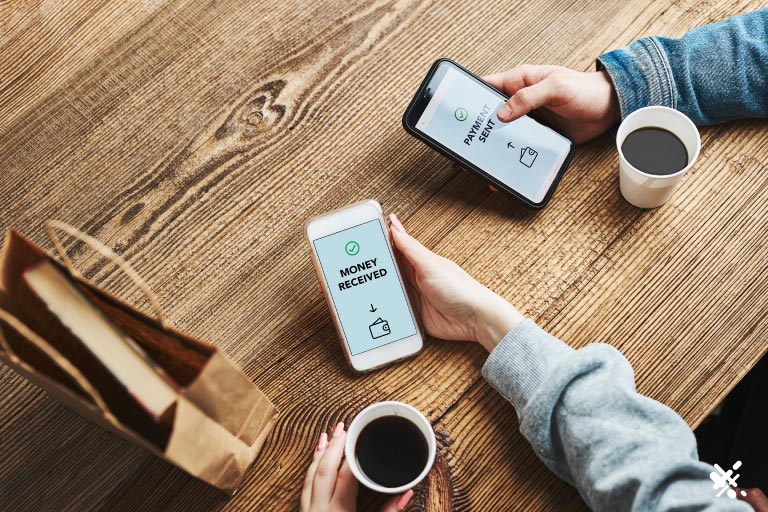
The Implosion of P2P Applications
Tied to mobile payments is the rise of P2P applications, or apps (as they are called). Apps like PayPal, CashApp, and Zelle allow consumers to send and receive payments in real-time. Around 84% of consumers have used P2P payments, and 44% of them use them at least once a week.
The most common reasons for using P2P applications are sending loved ones money (58%), splitting a restaurant or bar tab (41%), buying clothing (33%), groceries (33%), and entertainment (27%). These numbers vary by age group, but the overall takeaway is that P2P payment solutions are popular for a variety of reasons.
And that’s where it all comes together. Consumers are showing us that they not only will tolerate the use of phones to collect payment information—they like it. In some cases, there is even an added dimension of socialization. Venmo for instance, makes all transactions public unless you change the settings manually—resulting in some interesting one-liners.
Is Text to Pay Invasive?
In any case, texting is an overlooked opportunity for sending payment reminders. With the connotations carried by calling to collect a bill (lots of alliteration there), you might cringe at the idea of texting customers…hey—please pay me now.
There are indeed laws about placing phone calls to collect outstanding debts. Consumers consider this harassment, and the law corroborates their opinion. However, texting customers in-store to complete a purchase or a payment reminder about an upcoming installment payment is a much different matter.
Consumers are not likely to find texted payment requests invasive, especially when they know they are coming. They use their phones to make payments in stores, and they use their phones to split the cost of a pizza or a few beers. Receiving a payment link will be as seamless as asking them to swipe, insert, or tap their credit card at the point of sale.
But First, a Few Facts About Texting
As we mentioned earlier, consumers spend an average of 5.5 hours per day on their phones. Much of this time is spent on applications, such as social media, YouTube, shopping apps, and web browsing. Only 26 minutes of those (almost) 6 hours is spent texting, or just less than 8%.
But although consumers spend lots of time on applications, they are not always responsive to prompts on those apps. They may choose to ignore those thirsty DMs from creepy guys on Instagram who claim to know them from high school. Or the evening, after-work-hours email from a boss complaining about a certain project. Or an annoying friend request on Facebook they’d rather ignore for years on end.
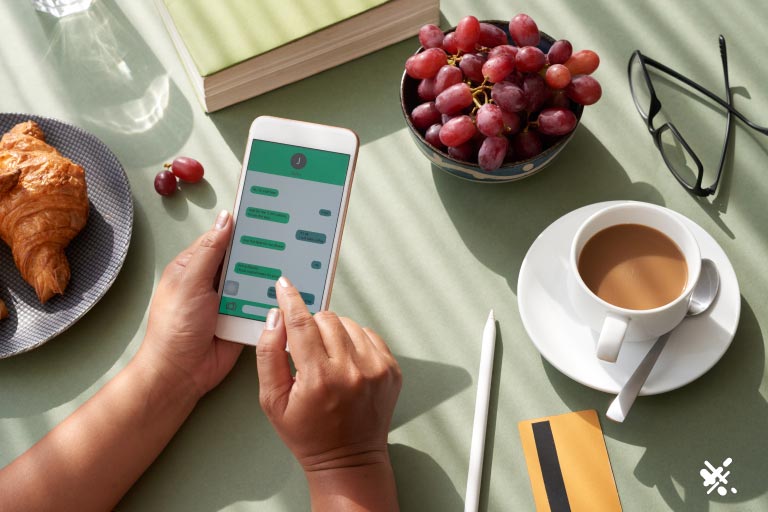
Texts Have a Phenomenal Open and Response Rate
Text messages have a 99% open rate, which is phenomenal. Even the highest-rated email open rate is around 49% (in case you’re wondering, it’s childcare-related emails opened by desperate parents). SMS response rates hover around 49%, which is far below the open rate, but still far above response rates to email, which is often around 6%.
As with everything else, there is some age-related demographic nuance to texting. Phone users between 35 and 44 send 52 texts per day (on average), making them the most frequently texting age group (and perhaps the ones with the strongest thumbs). All these facts tell us that while consumers are not texting all day, they take texts seriously and respond to them.
This particularly relates to text reminders about recurring payments. But response rates are pretty much guaranteed when you text customers in-store. That’s because they won’t be able to get what they want unless they read and respond to your text message.
What Does SMS Stand For?
Before proceeding, we should clear the air about texting versus SMS in terms of jargon. SMS stands for short message service. In some countries, they refer to SMS as SMS, and in others, they call it texting. We use the terms interchangeably.
There is something called MMS, which stands for multimedia messaging service. This is when you send pictures, videos, or a GIF to someone. It also includes website links. For this reason, SMS payment requests can technically be considered an MMS. However, for simplicity’s sake, we will still refer to it as SMS payments or pay-by-text.
Texting is Fun [insert emoji here]
On this topic, let’s mention why consumers continue to use SMS or text when other application options are available. Most cellular plans include unlimited texting these days, so consumers won’t add anything to their phone bill by texting as much as they want. The texting application is built into the phone already, so they don’t have to download anything extra.
Apple has gotten especially good at making texting functional and fun. Users can choose from 3,600 different emojis to express how they’re feeling. There are also special effects like fireworks, a spotlight, and confetti.
The autocorrect feature on the keyboard can make typing easier…or more difficult if you’re typing uncommon or foreign words. However, there are also foreign keyboards for dozens of languages. In all, texting is a very user-friendly platform for communication…one that you can leverage for collecting payments.

Using Short Codes for Text to Pay
Now that we’ve discussed how great the potential is for pay-by-text, let’s discuss how to set up text payments. One option is to have signage directing customers to text a keyword to a short code associated with your business. For example, you might have them text TACO to a five or six-digit number.
This number is the shortcode. It’s not 10 digits like a traditional phone number, but with only 4 or 6 digits, it’s easier for customers to type out. They’re also good for sending high volumes of text messaging in a short time.
In your case, that makes a lot of sense. You can’t be limited to manually texting one person a payment link at a time. You need to be able to handle multiple payment interactions at the same time.
Random and Vanity Short Codes
Business owners will usually have two options for obtaining a shortcode: random and vanity. A random code is (as you might guess) randomly generated and then assigned to your business. A vanity code is something you specifically choose.
If you’re wondering why you’d want to pay for that, it’s once again to make things easier for consumers. In this case, you can make the code easier to remember. Keep in mind that on most smartphones, alphabet characters associated with numbers are only on display for phone calls. This means that having the shortcode spell out something is probably irrelevant—customers won’t see that when they are texting anyway.
Sending the Text to Pay Link
Once the customer texts the keyword to the shortcode, they will receive a payment link. The payment link will take them to a payment gateway. Here the customer can input what they are ordering, and then input payment information.
The customer can then get some sort of confirmation code or order number. They will show this to a cashier to collect the goods or enjoy the services they have paid for. Take, for example, a movie theater. Customers inside the lobby can look at the selection of movies to choose from.
They can text a keyword to a shortcode, select their showtimes, and get tickets sent to their smartphone. They can then show these tickets to enter the theater and/or pick up some popcorn and snacks at a concession stand.
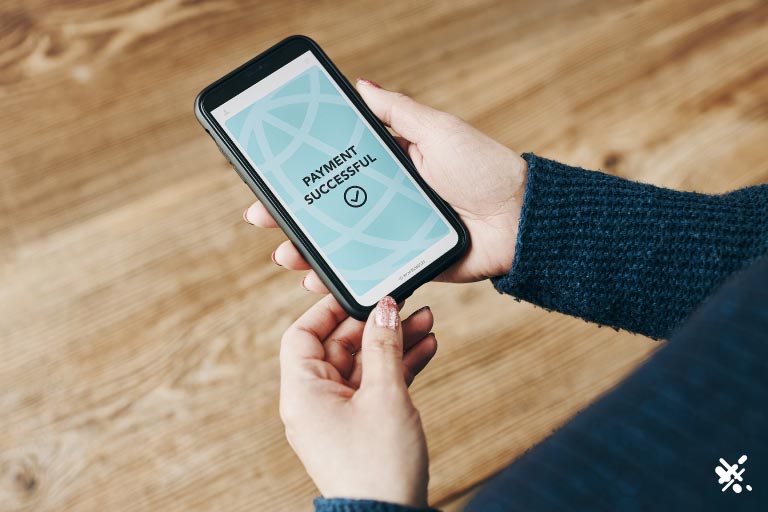
Can I Have Your Number?
Another option for initiating text to pay is to ask customers for their phone numbers. In-person, this can become a cumbersome experience, especially if you have a higher volume of foot traffic. In these situations, a sign displaying a shortcode and keyword makes life a lot easier. Text ICE CREAM to 23232 and select your favorite flavors! Then show your ticket to the cashier.
But things are a little different for subscription businesses and service-based businesses. If you are a service-based business, for example, you already have customer phone numbers. There’s a chance that you’ve called them on these numbers to discuss business or arrange a meeting time and place to discuss business.
With customer permission, you can initiate the sending of a payment link to the customer’s phone number. If they give you permission, you can also send text reminders about upcoming automatic payments, or periodic requests to make payments, if they are not on autopay.
Is Text to Pay the Same as a QR Code?
A QR code is a black-and-white checkerboard pattern that phone users can scan with their smartphone cameras. The camera will read this pattern and then prompt the phone user to click on a link. In terms of collecting payment, this link would be a payment gateway.
QR codes are becoming increasingly popular in restaurant settings because they can also steer customers to menus. The customer can order what they’d like, and settle their tab at the same time. There are no touching menus (a big concern for post-Covid consumers). There’s also a lot less time wasted on servers bringing cards to the back to run charges.
Tables can be turned faster (meaning, cleared and set for the next party). There’s a greater degree of efficiency made possible by directing diners to scan the QR code on the table. It all seems very similar to text to pay, but it’s not the same.
QR codes do not involve any text or SMS messaging. The similarity is that both paths to payment involve the customer using their phone to click on over to a payment gateway. The difference is that with text to pay, an actual text needs to be sent.
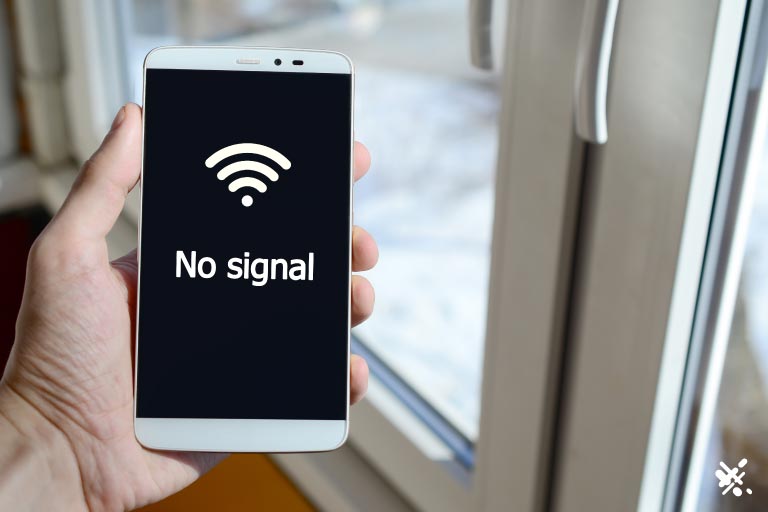
Where Does Text to Pay NOT Work?
Text to pay seems like an exciting automation in the payment landscape. But are there any scenarios where it won’t work? For one, text to pay will require an internet connection. That’s because the customer is getting directed to an online payment gateway.
In actuality, the customer just needs their phone to connect to the internet. But not everyone has roaming capabilities or wants to pay for them. So your best bet is to have in-house wifi.
Text to pay also might not work well in retail settings where customers hand a cashier a variety of items to scan, chosen from a large pool of potentials. Think of a department store or grocery store. Text to Pay links directs a phone user to an online payment gateway, where they must manually input what they are purchasing or pay an invoice that is already computed.
Getting a texted payment link and then having to select all the items you want to purchase is not convenient. In the future, however, it may be possible that text to pay will integrate with smartphone camera scanning. For instance, a consumer may get a payment link, and then be prompted to use their phone camera to scan barcodes.
That’s all very forward-thinking. For now, SMS payments require the customer to input what they are paying for. Or they present the customer with an already computed invoice. This won’t work in retail settings where they compile a cart from a wide variety of items.
Before Piggly Wiggly
Or will it? Once upon a time, when consumers went grocery shopping, they went to a general store. A clerk picked out all their desired items from behind the counter, assembled their bag, and rang up their purchase. Piggly Wiggly was the first store to change this up, by introducing the paradigm of aisles, carts, and picking stuff out yourself.
But in an interesting turn of events, some retailers may go back to the old way of doing things. First off, there is an implosion of curbside pickup. Curbside pickup really took off during the Covid pandemic, to help consumers avoid person-to-person contact. Consumers appreciated the convenience of curbside pickup, and a large number of businesses have retained the curbside pickup model as a key part of their sales model.
With curbside pickup, a consumer could indeed be sent a payment link via text. Signage could be posted outside a store or restaurant location. Consumers could get a text link, pick out what they want, and pay for their order—all from the comfort of their car.
But wait…there’s more. The sad truth of the matter is that retailers are experiencing large crime waves in certain cities. Until a muscular hero with a dark past arrives in black spandex and bat ears to take justice into his own hands, stores will have to respond. Some have responded by shuttering their urban locations for good. But others are creating new sales models.
Walgreens, for instance, has returned its Chicago stores to the old general-store model. Everything is behind the counter. Customers must place their orders by shopping online. They make their payment, and a clerk hands them their bag. This model will significantly cut down on crime…and it can leverage payment models like text to pay.
Are There Any Rules About Text to Pay?
In most states, you need to get permission to text customers and give them the option of opting out of future texts (usually by allowing them to text STOP). If you are having customers text a keyword to a shortcode, this is a form of obtaining permission.
Another consideration is staying PCI compliant. Payment Industry Standards are rules and regulations about saving customer credit and debit card information. There are specific practices businesses must adhere to, along with answering an annual questionnaire.
PCI compliance is expensive to set up, and expensive to maintain. It often involves building and servicing firewalls and other cybersecurity practices. While large corporations can afford this IT infrastructure, the average small business cannot.
The good news is that your payment processor can manage PCI compliance for you. They may also be the company to set up a text to pay platform for you to command. It may not look like the bridge of Starship Enterprise, but it will be a dashboard where you can manage sending out text to pay requests and/or monitor incoming ones.
Text to Pay Done For You
In all, the backend headaches of text to pay can be entirely managed by your payment processor. They may have in-house solutions for texting, or they may partner with another company that manages the actual SMS component.
Either way, text to pay can become a seamless way of facilitating contactless mobile payments. If you have any more questions about text to pay, like how it works or how to set it up, give us a call or fill out the contact form below.
